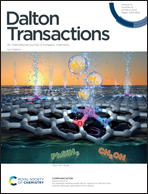Diosmium compounds containing bis(imidazole)-p-quinone bridging ligands†
Abstract
The doubly deprotonated bridging ligand L12− derived from 2,6-bis(2-pyridyl)-1,5-dihydro-1′,4′-benzoquinono[2′,3′-d:5′,6′-d′]diimidazole H2L1 forms coordination compounds with two bis(2,2′-bipyridine)osmium(II) complex fragments in anti ([1](ClO4)2) and syn configurations ([2](ClO4)2) of {(μ-L1)[Os(bpy)2]2}(ClO4)2, as evident from crystal structure analyses. Exchange of the metal-coordinating 2-pyridyl functions in the bridge through non-coordinating 4-tolyl substituents (L12− → L22−) leads to [3](ClO4)2 which involves chelation of the [Os(bpy)2]2+ groups through imidazole-N and carbonyl-O atoms of the central p-quinone function. In addition to identification, the compounds were subjected to electrochemical (CV, DPV) and spectroelectrochemical (UV-vis-NIR, EPR) analyses of electron transfer, the results being supported by results from TD-DFT calculations. Essential differences between [1n+]/[2n+] and [3n+] systems were found regarding variable but mostly metal centred oxidation, the two processes separated much more for [3n+]. The first reduction is bpy ([1+], [2+]) or quinone ligand centred ([3+]). Electronic structures and electron transfer behaviour are thus highly sensitive to differences of configuration and coordination.



 Please wait while we load your content...
Please wait while we load your content...